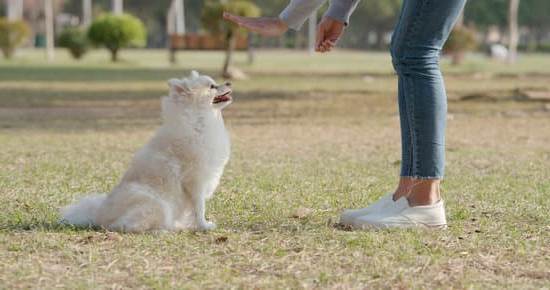Excessive barking can be a major source of frustration for both dog owners and their neighbors. Whether it’s triggered by strangers passing by, other animals, or simply boredom, constant barking can disrupt the peace in your home and community. The good news is that training your dog to keep quiet is not only possible, but also essential for their well-being and your sanity.
In this article, we will explore effective strategies to train your dog to keep from barking excessively. We will delve into the root causes of excessive barking and discuss how understanding canine communication can help us address this behavior. By establishing clear boundaries, using positive reinforcement techniques, and implementing distraction techniques, you can take control of your dog’s bark.
Throughout the article, we will provide step-by-step instructions on desensitizing dogs to external stimuli that trigger excessive barking. We will also introduce various tools and training aids that can assist in controlling barking. It’s important to remember that consistency and patience are key when training your dog to stay quiet. Additionally, we will tackle specific scenarios and challenges you may encounter during the training process and offer troubleshooting advice.
By following our tips for maintenance and ongoing training, you can ensure long-term success in curbing excessive barking. Ultimately, our goal is for you to celebrate your triumphs in training your furry friend and enjoy a peaceful and quiet living environment together. So let’s get started on creating harmony between you, your dog, and those around you.
Exploring the Root Causes of Excessive Barking
Dogs communicate through barking, and it is important to understand the underlying reasons behind excessive barking in order to effectively train your dog to keep quiet. By exploring the root causes of excessive barking, you can better address these issues and establish a more peaceful living environment for both you and your furry companion.
One common cause of excessive barking is anxiety or fear. Dogs may bark excessively when they feel threatened or uncomfortable in certain situations. It is important to identify what triggers your dog’s anxiety and work on desensitizing them to those stimuli. This can be done through gradual exposure and positive reinforcement techniques.
Another reason dogs bark excessively is to seek attention or as a form of boredom. If your dog feels neglected or lacks mental stimulation, they may resort to barking as a means of gaining attention or relieving boredom. To address this issue, it is essential to provide your dog with regular exercise, mental enrichment activities, and quality time spent together.
In some cases, territorial instincts can also contribute to excessive barking. Dogs have a natural instinct to protect their territory, and when they perceive a threat or intrusion, they may bark excessively in an attempt to ward off the perceived threat. By establishing clear boundaries and rules for your dog, you can help them understand what constitutes a legitimate threat and when it is appropriate to bark.
Step 1
Understanding the Importance of Boundaries
Establishing clear boundaries and rules for your dog is an essential first step in minimizing barking triggers. Dogs thrive in an environment where they understand their role and what is expected of them. By setting these boundaries, you can create a structured and predictable living environment that helps your dog feel secure and less likely to engage in excessive barking.
Creating Consistent Rules
Consistency is key when establishing boundaries for your dog. Make sure everyone in your household is on the same page and follows the same set of rules. Dogs are intelligent animals and can quickly become confused if different people enforce different behaviors. Decide what behaviors are acceptable and unacceptable, such as barking at guests or unnecessary noise outside, and ensure everyone consistently enforces these rules.
Providing Clear Communication
To effectively establish boundaries, it’s important to communicate clearly with your dog. Use simple commands like “quiet” or “enough” to signal that barking is not desired. Say the command firmly but calmly, avoiding angry or frustrated tones that might escalate the situation. Be consistent with this command whenever your dog starts barking unnecessarily, reinforcing the idea that they should be quiet when given the command.
Removing Reinforcement for Undesirable Behaviors
In addition to providing clear communication, it’s crucial to remove any reinforcement for undesirable behaviors. If your dog continues barking after being given the quiet command, avoid giving them attention or rewards during that time. This includes eye contact, physical touch, or verbal reassurance. Giving attention during unwanted behavior can inadvertently reinforce it, making it more difficult to curb excessive barking in the long run.
By establishing clear boundaries and rules through consistent communication and removing reinforcement for undesired behavior, you can minimize barking triggers in your dog. Creating a structured living environment will help your dog feel secure and understand their role, leading to a quieter and more peaceful living environment for both you and your furry friend.
Step 2
Positive reinforcement techniques are a highly effective and humane way to train dogs to stay quiet. These techniques focus on rewarding desired behaviors rather than punishing unwanted ones, creating a positive association for the dog and encouraging them to repeat those behaviors.
One of the most important aspects of positive reinforcement is timing. The reward should be given immediately after the dog exhibits the desired behavior, so they can clearly understand what they are being rewarded for. This could be a treat, praise, or a toy – whatever motivates your dog.
To begin training your dog to stay quiet using positive reinforcement, start by choosing a command such as “quiet” or “enough” that you will use consistently. When your dog starts barking, calmly say the command and wait for them to stop barking even for a second. As soon as they do, praise them and reward them with a treat or other form of positive reinforcement.
Consistency is key in this process. Every time your dog follows the command and stops barking, reward them. Over time, you can gradually increase the duration of silence required before giving the reward. This helps reinforce the behavior further and teaches your dog to stay quiet for longer periods of time.
It’s important to note that while positive reinforcement is effective, it may not work overnight. Some dogs may take longer to learn than others, so patience is essential. It’s also crucial to avoid any punishment or negative reinforcement during this training process as it can cause fear and anxiety in your dog.
In summary, positive reinforcement techniques are an excellent way to train dogs to stay quiet. By rewarding desired behaviors instead of punishing unwanted ones, you create a positive association for your dog and encourage them to repeat those behaviors in the future. Consistency, timing, and patience are key elements in successfully teaching your dog to stay quiet using these techniques.
| Technique | Description |
|---|---|
| Choose a command | Select a specific command to use consistently when your dog barks. |
| Immediate reward | Reward your dog with treats, praise, or toys immediately after they stop barking. |
| Consistency and repetition | Be consistent in using the command and rewarding your dog every time they stop barking. Gradually increase the duration of silence required before giving the reward. |
| Avoid punishment or negative reinforcement | Avoid punishing or scolding your dog during the training process, as it can cause fear and anxiety. |
Utilizing Distraction Techniques
Excessive barking can be a frustrating behavior to deal with as a dog owner. One effective technique to curb this behavior is to utilize distraction techniques that redirect your dog’s attention away from barking. By engaging your dog in alternative activities and providing them with mental stimulation, you can help reduce their urge to bark unnecessarily.
Interactive Toys
One way to distract your dog from barking is by providing them with interactive toys. These toys are designed to keep your dog mentally stimulated and engaged, offering a healthy outlet for their energy and preventing boredom that could lead to excessive barking. Puzzle toys, treat dispensers, and chew toys are great options for keeping your dog occupied while diverting their attention from barking.
Obedience Training
Teaching your dog basic obedience commands can also be an effective distraction technique. By practicing commands such as “sit,” “stay,” or “down,” you can redirect their focus and shift their attention away from barking. Consistent training sessions will help strengthen the connection between you and your dog, providing a strong foundation for them to rely on when they feel the need to bark excessively.
Physical Exercise
Physical exercise is crucial in maintaining a well-balanced lifestyle for dogs, particularly those prone to excessive barking due to pent-up energy or frustration. Regular walks, playtime in the backyard, or engaging in fun activities like agility training can not only tire out your furry friend but also provide a useful distraction from barking. A tired dog is usually a contented one and less likely to engage in unnecessary noise-making.
It’s important to note that distractions should be used alongside positive reinforcement techniques for maximum effectiveness when training your dog not to bark excessively. Remember that consistency is key; continue to redirect their attention using these techniques whenever they exhibit the undesired behavior. By utilizing distraction techniques, you can help your dog develop healthier habits and create a more peaceful living environment for both of you.
Step 3
Excessive barking can often be triggered by external stimuli such as other animals, loud noises, or unfamiliar people. To address this issue, it is important to gradually desensitize your dog to these triggers. By exposing your dog to these stimuli in a controlled and positive manner, you can help them become less reactive and reduce their barking. Here are some steps you can take for gradual desensitization:
- Identify the specific triggers: Observe your dog’s behavior and identify the specific stimuli that cause them to bark excessively. This could be the sound of the doorbell, passing cars, or even squirrels in the backyard.
- Create a calm and safe environment: Before starting the desensitization process, make sure your dog is in a calm and relaxed state. Create a soothing environment by eliminating any potential stressors and providing comfortable bedding or toys.
- Introduce the triggers gradually: Begin by introducing your dog to a very low-intensity version of the trigger that causes them to bark. For example, if they bark at the sound of the doorbell, start by playing a recording of it at a very low volume.
- Reward calm behavior: When your dog remains calm in response to the trigger, reward them with treats or praise. This positive reinforcement will help reinforce the desired behavior of staying quiet.
- Increase intensity over time: Slowly increase the intensity of the trigger while continuously rewarding calm behavior from your dog. Gradually expose them to louder doorbell sounds or more challenging scenarios.
- Seek professional help if needed: If you find that your dog is not responding well to gradual desensitization or if their barking persists, consider seeking assistance from a professional dog trainer or animal behaviorist. They can provide guidance and tailored techniques based on your specific situation.
Remember, desensitization takes time and patience. It is essential to go at your dog’s pace and not rush the process. With consistent training and positive reinforcement, you can help your dog become less reactive to external stimuli and reduce their excessive barking.
Effective Tools and Training Aids to Assist in Controlling Barking
Understanding the Role of Tools and Training Aids
Controlling excessive barking requires more than just verbal commands and positive reinforcement. To assist in your training efforts, there are various tools and aids available that can help curb your dog’s barking behavior.
While these tools are not meant to replace proper training techniques, they can provide additional support and enhance the effectiveness of your training sessions. It’s important to note that each dog is unique, so it may take some trial and error to determine which tools work best for your furry friend.
Bark Collars: An Effective Training Tool
One popular tool that dog owners often turn to is the bark collar. Bark collars come in different types, including citronella spray collars, vibration collars, and static correction collars. These collars are designed to deliver a distraction or mild corrective stimulation when your dog barks excessively. The idea behind bark collars is to associate the undesirable behavior with an uncomfortable sensation, encouraging the dog to refrain from barking.
Before using a bark collar, it’s essential to consult with a professional trainer or veterinarian who can guide you on selecting the appropriate type for your dog’s size, temperament, and specific needs. Additionally, ensure that the collar is properly fitted and used according to the manufacturer’s instructions.
Sound Machines and White Noise
Another useful tool in controlling barking is sound machines or white noise devices. These devices emit soothing sounds or white noise that can help mask external stimuli that may trigger excessive barking in dogs. By creating a consistent background noise level, sound machines help create a calm environment for your dog and minimize their reactivity to noises such as doorbells or sirens.
When using sound machines or white noise devices, it’s important to place them strategically in areas where your dog spends most of their time or where they commonly exhibit barking behavior. Gradually increase the volume to drown out outside noises but ensure that it doesn’t become too loud to cause discomfort or stress for your pet.
Treat-Dispensing Toys and Puzzle Feeders
Incorporating interactive toys and puzzle feeders into your dog’s routine can also be effective in diverting their attention away from barking. Treat-dispensing toys and puzzle feeders require dogs to work for their food, providing mental stimulation and a distraction from barking.
These toys are designed to hold treats or kibble, challenging your dog to figure out how to access the reward. By engaging their mind and satisfying their natural instinct to chew and hunt for food, these toys redirect their focus and energy towards a more rewarding activity, reducing the likelihood of excessive barking.
Remember that training aids should be used as supplements, not replacements, for proper training techniques. It’s crucial to use them in conjunction with positive reinforcement, clear boundaries, and consistent training methods discussed earlier in this article. With the right tools and diligent training efforts, you’ll be well on your way to successfully curbing your dog’s excessive barking behavior.
The Role of Consistency and Patience in Successfully Training Your Dog to Keep Quiet
Consistency and patience are crucial factors in successfully training your dog to avoid excessive barking. Dogs thrive on routine and clear expectations, so it is important to establish consistent rules and boundaries from the beginning of the training process.
One way to maintain consistency is by using a command word or phrase consistently when addressing your dog’s barking behavior. For example, you can use the command “quiet” or “enough” to signal to your dog that they should stop barking. Use this command every time your dog begins to bark excessively, and reward them when they comply by staying quiet.
Another important aspect of consistency is ensuring that all members of the household follow the same training protocols. If one person allows the dog to bark freely while others are working on training techniques, it can confuse the dog and hinder progress. It is important for everyone in the household to be on board with the training plan and consistently enforce the rules.
Patience is key when training your dog to keep quiet. It takes time for them to learn new behaviors and break old habits. Be prepared for setbacks and be patient with your furry friend as they navigate through the learning process. Remember to stay calm and composed throughout the training sessions, as dogs can pick up on our emotions.
In addition to consistency and patience, it is essential to create a positive environment during training sessions. Use positive reinforcement techniques such as treats, praise, and rewards whenever your dog demonstrates desired behavior by staying quiet. This helps them associate being quiet with positive outcomes, which encourages them to continue behaving in such a manner.
By being consistent with your commands, enforcing rules across all family members, practicing patience, and incorporating positive reinforcement techniques, you will greatly increase your chances of successfully training your dog to keep quiet.
Troubleshooting
Training a dog to keep quiet can sometimes present unique challenges depending on the individual dog and the specific situation. In this section, we will address some common scenarios and challenges that dog owners may encounter during the training process and provide guidance on how to overcome them.
One common challenge is dealing with separation anxiety. Dogs with separation anxiety tend to bark excessively when left alone, which can be distressing for both the dog and their owner. To address this issue, it is important to gradually desensitize your dog to being alone.
Start by leaving your dog alone for short periods of time and gradually increase the duration as they become more comfortable. Provide them with engaging toys or puzzles to keep them occupied while you are away.
Another common scenario is dealing with territorial barking. Dogs often bark excessively when they feel that their territory is being threatened, such as when someone approaches their home or property. To address this behavior, it is important to establish clear boundaries for your dog and teach them appropriate responses to perceived threats. Use positive reinforcement techniques to reward calm behavior and redirect their attention away from barking.
Some dogs may also exhibit excessive barking due to fear or anxiety. This can be triggered by various stimuli such as loud noises, unfamiliar people or animals, or new environments. To help your dog overcome these fears, it is important to gradually expose them to these stimuli in a controlled and positive manner. Use counter-conditioning techniques by pairing the feared stimulus with something your dog enjoys, such as treats or playtime.
It is worth noting that every dog is unique and may require different approaches or additional training methods based on their individual temperament and history. If you are facing challenges during the training process that you are unable to resolve on your own, consider seeking guidance from a professional dog trainer or behaviorist who can provide personalized advice and support.
In summary, troubleshooting specific scenarios and challenges during the training process is essential for successfully training a dog to keep quiet. Addressing separation anxiety, territorial barking, and fear or anxiety-related barking requires patience, consistency, and the use of positive reinforcement techniques.
Remember that each dog is different, so it may be necessary to seek professional guidance if you encounter difficulties along the way. By addressing these challenges effectively, you can ensure long-term success in curbing excessive barking and enjoy a peaceful living environment with your well-trained dog.
| Scenario/Challenge | Solution |
|---|---|
| Separation Anxiety | – Gradually desensitize the dog to being alone\n – Provide engaging toys or puzzles while away\n – Seek professional help if needed |
| Territorial Barking | – Establish clear boundaries for the dog\n – Teach appropriate responses to perceived threats\n – Use positive reinforcement techniques |
| Fear or Anxiety-Related Barking | – Gradually expose the dog to feared stimuli in a controlled manner\n – Pair stimuli with something enjoyable for the dog\n – Consult a professional if needed |
Maintenance and Ongoing Training Tips
Maintaining a well-trained dog that knows how to control its excessive barking requires ongoing training and consistent reinforcement. Here are some maintenance and ongoing training tips to ensure long-term success in curbing excessive barking:
- Continue practicing commands: Reinforcing the commands you’ve taught your dog during the initial training period is important for maintaining their understanding and response. Make sure to continue practicing commands like “quiet” or “enough” regularly, rewarding them when they comply and staying patient when they need reminders.
- Provide mental stimulation: Boredom can often be a trigger for excessive barking. To prevent this, make sure your dog gets plenty of mental stimulation through activities like puzzle toys, interactive games, or obedience training sessions. Mental exhaustion can help keep them calm and occupied, reducing the chances of unnecessary barking.
- Address underlying health issues: Sometimes excessive barking may be a sign of an underlying health problem, such as anxiety or discomfort. If you notice persistent excessive barking despite your efforts in training, consult with a veterinarian to rule out any potential medical conditions that may be causing the behavior.
- Slowly increase exposure to triggers: Gradually increasing your dog’s exposure to triggering stimuli can help desensitize them over time. For example, if your dog tends to bark at other dogs during walks, gradually introduce controlled interactions with familiar and well-behaved dogs in a controlled environment. Reward your dog for remaining calm and not barking during these interactions.
- Consistency is key: To maintain long-term success in curbing excessive barking, it’s crucial to remain consistent in your approach and expectations. Be clear with your boundaries and rules from the beginning and consistently reinforce them through positive reinforcement techniques.
| Tips | Explanation |
|---|---|
| Continue practicing commands | Reinforce the commands regularly to maintain understanding and response from your dog. |
| Provide mental stimulation | Engage your dog in activities that keep them mentally stimulated, reducing boredom-induced barking. |
| Address underlying health issues | If excessive barking persists despite training, consult with a veterinarian to rule out any potential medical causes. |
| Slowly increase exposure to triggers | Gradually introduce triggering stimuli in controlled settings to help desensitize your dog over time. |
| Consistency is key | Maintain consistent boundaries and rules, reinforcing them through positive reinforcement techniques. |
Conclusion
In conclusion, training your dog to keep from barking excessively is a process that requires patience, consistency, and understanding. By following the steps outlined in this article, you can establish clear boundaries and rules for your dog, utilize positive reinforcement techniques, and gradually desensitize them to external stimuli.
Remember the importance of consistency and patience throughout the training process. It may take time for your dog to fully understand and respond to the training methods you are using. Stay committed and keep reinforcing the desired behavior with positive reinforcement. Consistency will help solidify the training in your dog’s mind and create lasting change.
Additionally, it is important to address any specific scenarios or challenges that arise during the training process. Troubleshooting these issues will ensure that you are able to overcome obstacles and continue making progress with your dog’s barking behavior. Seek professional help if needed or consult with a trainer who specializes in behavioral issues.
Once you have successfully trained your dog to keep quiet, it is important to maintain their new behavior by consistently reinforcing the rules you have established. Ongoing training tips can assist in reinforcing good behavior over time.
Ultimately, by investing time and effort into training your dog not to bark excessively, you can create a peaceful and quiet living environment for both you and your well-trained canine companion. Enjoy the benefits of a well-behaved dog who understands how to communicate without excessive barking. Your hard work will pay off as you celebrate your success in achieving a harmonious relationship with your beloved pet.
Frequently Asked Questions
How do I get my dog to stop barking at everything?
To get your dog to stop barking at everything, it is important to identify the cause of their excessive barking. Dogs may bark due to various reasons such as boredom, fear, attention-seeking, or territorial instincts. Addressing the underlying cause is crucial in solving this issue. First, make sure your dog is getting enough physical and mental exercise to reduce boredom.
Provide them with plenty of toys and engage them in activities that keep their minds occupied. It may also help to desensitize your dog to the triggers that make them bark excessively. Gradually exposing them to the stimuli while rewarding calm behavior can help them become more accustomed and less reactive over time. Consistency and positive reinforcement are key in training your dog to stop barking excessively.
What is the 3 bark rule?
The 3 bark rule is a guideline for distinguishing between normal barking behavior and excessive barking that needs intervention. According to this rule, if a dog barks three times within a short period and then stops on their own, it is likely just regular communication or alerting behavior.
However, if the dog continues barking incessantly beyond those three initial barks, it may indicate an underlying issue that needs attention. This could include anxiety, fear, or some form of discomfort or distress that requires intervention from the owner or professional training.
What is a good command for a dog to stop barking?
A useful command for teaching a dog to stop barking is “quiet” or “enough.” It’s important to associate this command with specific actions so that your dog understands what is expected of them when you give this command. Start by monitoring their behavior for any signs of excessive barking and catch them in the act but before they escalate into prolonged episodes. As soon as they start barking excessively, firmly say “quiet” or “enough” while making eye contact with them and using a hand signal if necessary.
Once they stop barking, reward them with praise and treats immediately as positive reinforcement. Consistency is key when teaching this command, so ensure that everyone in the household follows the same procedure and reinforces it consistently. Gradually, your dog will start to understand that being quiet after hearing this command results in a favorable outcome.

Welcome to the blog! I am a professional dog trainer and have been working with dogs for many years. In this blog, I will be discussing various topics related to dog training, including tips, tricks, and advice. I hope you find this information helpful and informative. Thanks for reading!





